IMDRF MDCE WG/N55 FINAL:2019 (formerly GHTF/SG5/N1R8:2007) Clinical Evidence - Key Definitions and Concepts - PDF (185kb)
标准简介
Clinical Evidence - Key Definitions and Concepts - PDF (185kb)[附网盘链接]由Medical Device Clinical Evaluation Working Group于10 October 2019发布,适用于世界。标准截图
![Clinical Evidence - Key Definitions and Concepts - PDF (185kb)[附网盘链接]](/img/20210914103508bpc4w.jpg)
标准文档说明
标准文档类型为Clinical Evidence - Key Definitions and Concepts - PDF (185kb)[附网盘链接]高清PDF版本(文字版),标准文档内可进行搜索,可以复制原文,可粘贴。标准部分原文
1.0 Introduction
This document supersedes an earlier version produced under the Global Harmonization Task
1
Force (GHTF) with the same title in May, 2007(GHTF/SG5/N1R8:2007).
It is anticipated that convergence of requirements for clinical evidence, including common data
submissions, will lead to better understanding of medical device safety, clinical performance
and/or effectiveness by all stakeholders, more efficient use of resources of the clinical
community, medical device regulators and industry, and increased transparency and confidence
in the global regulatory model. Ultimately, there should be more efficient, predictable and
timely access to safe and effective medical technology by patients and society worldwide.
Clinical evidence and the Essential Principles of safety and performance of medical devices
The IMDRF Essential Principles of Safety and Performance of Medical Devices and IVD
Medical Devices (the Essential Principles) set out the requirements relating to the safety and
performance of medical devices. Of these, Essential Principles 5.1.1, 5.1.6, 5.1.7 and 5.1.9 in
particular require that a medical device achieve its intended performance during use according to
its labelling and that the known, and foreseeable risks, and any undesirable side-effects, are
minimised and acceptable when weighed against the benefits of the intended performance.
The diversity of medical devices and the technologies on which they are based pose special
challenges for manufacturers, conformity assessment bodies and regulators alike when trying to
identify what should constitute evidence sufficient to demonstrate compliance with the Essential
Principles. Some technologies have been available for many years and are well characterised
from a safety, clinical performance and/or effectiveness viewpoint. On the other hand, many
medical devices utilise new, state-of-the-art technology that has had little prior application in
the treatment of humans.
Furthermore, their intended purpose and clinical application can vary widely with end results
influenced by a wide range of different and differently experienced end-users.
Given the complexity of the medical devices milieu, the assessment of what is acceptable clinical
evidence for the purpose of demonstrating compliance with the Essential Principles must be
undertaken on a case-by-case basis. To this end, it is important to have an understanding of how
medical devices are brought to market and of the role that clinical data and its evaluation plays in
this process.
2.0 Scope
This document is intended to:
· introduce the concepts of clinical evaluation and clinical evidence;
· examine the relationship between clinical investigation, clinical data, clinical evaluation and
1
This document is intended to provide an update on definitions and other terminology arising from regulatory
updates in different regions. It does not update methodology such that it reflects a (best practice) life cycle approach.
Page 4 of 8
October 10, 2019
网盘链接
百度网盘:https://pan.baidu.com/s/1qycbxKPhTMilS3JpBg1nfA
提取码:vgap
【温馨提示】大资料ISO是提供信息发布的专业信息类网站,所有内容均由用户发布,不代表本站观点,本站亦不存储所涉及的文件及资料。如有【免费资料】以及【付费资料】,请用户根据自己的需求,自行判断是否需要获取。如有交易诈骗、内容侵权可发送邮件至kf@dzl100.com,我们审查后若发现情况属实,会立即对相关内容进行删除处理。
加载用时:107.9779 毫秒
相关评论
相关文章
-
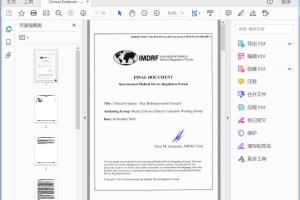
IMDRF MDCE WG/N55 FINAL:2019 (formerly GHTF/SG5/N1R8:2007) Clinical Evidence - Key Definitions and Concepts - PDF (185kb)
Clinical Evidence - Key Definitions and Concepts - PDF (185kb)[附网盘链接]是Medical Device Clinical Evaluation Working Group于10 October 2019发布的GHTF标准,适用于世界。本次分享的标准文档为高清PDF(文字版),标准文档内可搜索,可复制,可粘贴。本文结尾附网盘链接。
-
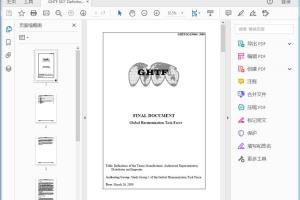
GHTF/SG1/N055: 2009 GHTF SG1 - Definition Terms - Manufacturer - Authorised Representative - Distributor and Importer - PDF (41kb)
GHTF SG1 - Definition Terms - Manufacturer - Authorised Representative - Distributor and Importer - PDF (41kb)[附网盘链接]是Study Group 1 of the Global Harmonization Task Force于March 26, 2009发布的GHTF标准,适用于世界范围。本次分享的标准文档为高清PDF(文字版),标准文档内可搜索,可复制,可粘贴。本文结尾附网盘链接。
-

GHTF/SG3/N18:2010 GHTF SG3 - Quality management system - Medical Devices - Guidance on corrective action and preventive action and related QMS processes - November 2010 - PDF (254kb)
GHTF SG3 - Quality management system - Medical Devices - Guidance on corrective action and preventive action and related QMS processes - November 2010 - PDF (254kb)[附网盘链接]是Study Group 3于4 November 2010发布的GHTF标准,适用于世界。本次分享的标准文档为高清PDF(文字版),标准文档内可搜索,可复制,可粘贴。本文结尾附网盘链接。
-
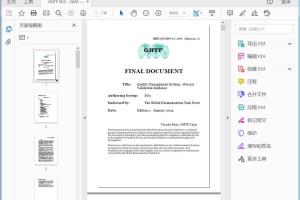
GHTF/SG3/N99-10:2004 (Edition 2) GHTF SG3 - QMS - Process Validation Guidance - January 2004 - PDF (162kb)
GHTF SG3 - QMS - Process Validation Guidance - January 2004 - PDF (162kb)[附网盘链接]是SG3于Edition 2 - January 2004发布的GHTF标准,适用于世界。本次分享的标准文档为高清PDF(文字版),标准文档内可搜索,可复制,可粘贴。本文结尾附网盘链接。
-

GHTF/SG3/N17:2008 GHTF SG3 - Quality Management System - Medical Devices - Guidance on the Control of Products and Services Obtained from Suppliers - December 2008 - PDF (593kb)
GHTF SG3 - Quality Management System - Medical Devices - Guidance on the Control of Products and Services Obtained from Suppliers - December 2008 - PDF (593kb)[附网盘链接]是GHTF Study Group 3于December 11, 2008发布的GHTF标准,适用于全球范围。本次分享的标准文档为高清PDF(文字版),标准文档内可搜索,可复制,可粘贴。本文结尾附网盘链接。
-
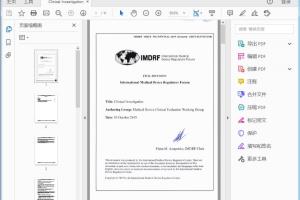
IMDRF MDCE WG/N57FINAL:2019 (formerly GHTF/SG5/N3:2010) Clinical Investigation - PDF (267kb)
Clinical Investigation - PDF (267kb)[附网盘链接]是Medical Device Clinical Evaluation Working Group于10 October 2019发布的GHTF标准,适用于全球范围。本次分享的标准文档为高清PDF(文字版),标准文档内可搜索,可复制,可粘贴。本文结尾附网盘链接。
-
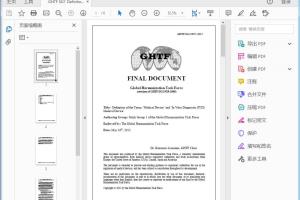
GHTF/SG1/N071:2012 GHTF SG1 - Definition of Terms Medical Device and In Vitro Diagnostic Medical Device - May 2012 - PDF (240kb)
GHTF SG1 - Definition of Terms Medical Device and In Vitro Diagnostic Medical Device - May 2012 - PDF (240kb)[附网盘链接]是Study Group 1 of the Global Harmonization Task Force于May 16 , 2012发布的GHTF标准,适用于世界。本次分享的标准文档为高清PDF(文字版),标准文档内可搜索,可复制,可粘贴。本文结尾附网盘链接。
-

IMDRF MDCE WG/N55 FINAL:2019 (formerly GHTF/SG5/N1R8:2007) Clinical Evidence - Key Definitions and Concepts - PDF (185kb)
Clinical Evidence - Key Definitions and Concepts - PDF (185kb)[附网盘链接]是Medical Device Clinical Evaluation Working Group于10 October 2019发布的GHTF标准,适用于世界。本次分享的标准文档为高清PDF(文字版),标准文档内可搜索,可复制,可粘贴。本文结尾附网盘链接。
-

IMDRF/GRRP WG/N47 FINAL:2018 Essential Principles of Safety and Performance of Medical Devices and IVD Medical Devices - PDF (260kb)
Essential Principles of Safety and Performance of Medical Devices and IVD Medical Devices - PDF (260kb)[附网盘链接]是IMDRF Good Regulatory Review Practices Group于31 October 2018发布的GHTF标准,适用于世界。本次分享的标准文档为高清PDF(文字版),标准文档内可搜索,可复制,可粘贴。本文结尾附网盘链接。
-
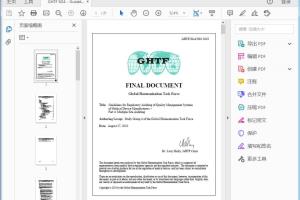
GHTF/SG4/N83:2010 GHTF SG4 - Guidelines for Regulatory Auditing of Quality Management Systems of Medical Device Manufacturers - Part 4 Multiple Site Auditing - August 2010 - PDF (157kb)
GHTF SG4 - Guidelines for Regulatory Auditing of Quality Management Systems of Medical Device Manufacturers - Part 4 Multiple Site Auditing - August 2010 - PDF (157kb)[附网盘链接]是Study Group 4 of the Global Harmonization Task Force于August 27, 2010发布的GHTF标准,适用于全球。本次分享的标准文档为高清PDF(文字版),标准文档内可搜索,可复制,可粘贴。本文结尾附网盘链接。
-
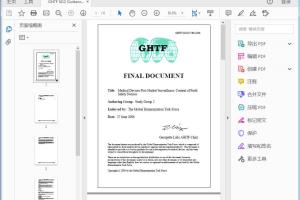
GHTF/SG2/N57R8:2006 GHTF SG2 - Guidance - Content of Field Safety Notices - PDF (58kb)
GHTF SG2 - Guidance - Content of Field Safety Notices - PDF (58kb)[附网盘链接]是Study Group 2于27 June 2006发布的GHTF标准,适用于全球。本次分享的标准文档为高清PDF(文字版),标准文档内可搜索,可复制,可粘贴。本文结尾附网盘链接。
-
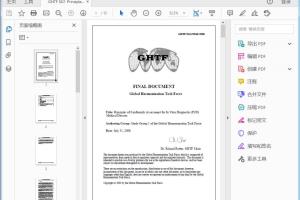
GHTF/SG1/N046:2008 GHTF SG1 - Principles of CA for IVD Medical Devices - July 2008 - PDF (87kb)
GHTF SG1 - Principles of CA for IVD Medical Devices - July 2008 - PDF (87kb)[附网盘链接]是Study Group 1 of the Global Harmonization Task Force于July 31, 2008发布的GHTF标准,适用于全球范围。本次分享的标准文档为高清PDF(文字版),标准文档内可搜索,可复制,可粘贴。本文结尾附网盘链接。
-
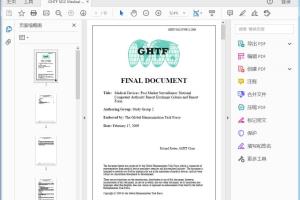
GHTF/SG2/N79R11:2009 GHTF SG2 - Medical Devices Post Market Surveillance - February 2009 - PDF (142kb)
GHTF SG2 - Medical Devices Post Market Surveillance - February 2009 - PDF (142kb)[附网盘链接]是Study Group 2于February 17, 2009发布的GHTF标准,适用于世界。本次分享的标准文档为高清PDF(文字版),标准文档内可搜索,可复制,可粘贴。本文结尾附网盘链接。
-
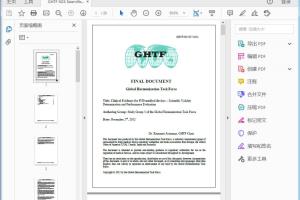
GHTF/SG5/N7:2012 GHTF SG5 Scientific Validity Determination and Performance Evaluation - November 2012 - PDF (746kb)
GHTF SG5 Scientific Validity Determination and Performance Evaluation - November 2012 - PDF (746kb)[附网盘链接]是Study Group 5 of the Global Harmonization Task Force于November 2 , 2012发布的GHTF标准,适用于全球。本次分享的标准文档为高清PDF(文字版),标准文档内可搜索,可复制,可粘贴。本文结尾附网盘链接。
-
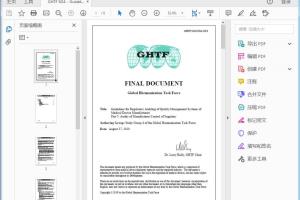
GHTF/SG4/N84:2010 GHTF SG4 - Guidelines for Regulatory Auditing of Quality Management Systems of Medical Device Manufacturers. Part 5 Audits of Manufacturer Control of Suppliers - August 2012 - PDF (96kb)
GHTF SG4 - Guidelines for Regulatory Auditing of Quality Management Systems of Medical Device Manufacturers. Part 5 Audits of Manufacturer Control of Suppliers - August 2012 - PDF (96kb)[附网盘链接]是Study Group 4 of the Global Harmonization Task Force于August 27, 2010发布的GHTF标准,适用于世界范围。本次分享的标准文档为高清PDF(文字版),标准文档内可搜索,可复制,可粘贴。本文结尾附网盘链接。